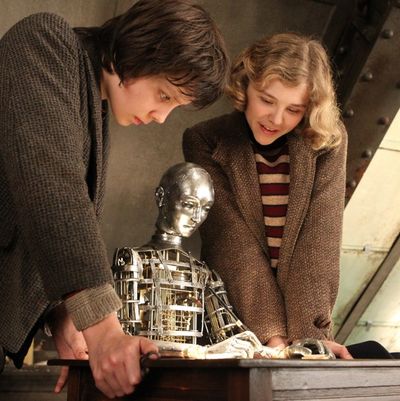
In Hugo, Martin Scorsese is hell-bent on bedazzling us, and Scorsese rarely doesn’t get what Scorsese wants — by any means necessary. The means in this case are to swoon over. Together with a bunch of A-plus-list artists and techies, he has crafted a deluxe, gargantuan train set of a movie in which he and his 3-D camera can whisk and whizz and zig and zag, a place where he can show off all his expensive toys and wax lyrical within the film itself on the magic of movies. Marty the film buff has built his own matrix.
It is not, however, a source of endless delight to the eponymous 12-year-old hero (Asa Butterfield), who lives in a dark flat in the bowels of the Paris train station, orphaned, abandoned, and forced to steal. Hugo’s drunken-uncle guardian (Ray Winstone) had the job of setting the station’s clocks until he suddenly went missing. So now the boy, to cover for the disappearance and stay out of the orphanage, does the job in secret, stealing through tunnels, up rickety ladders, and over catwalks, careful to avoid the station master (Sacha Baron Cohen) with his zest for orphan-catching. Hugo’s only company is a non-working automaton, a kind of primitive mechanical man that his late dad (Jude Law, seen in flashback reveries) discovered in a museum storage area. The boy has a supernatural inkling that the automaton holds the key to his future. Alas, the key the automaton doesn’t hold is the one that would wind it up and set it in motion. The messenger is mute — for the moment.
Working from a fleet, shapely script by John Logan (based on the illustrated novel The Invention of Hugo Cabret by Brian Selznick, of those Selznicks), Scorsese and production designer Dante Ferretti pack the screen with clocks and gears and cogs and other round objects that also evoke film canisters, which appear later when turn-of-the-twentieth-century pioneer fantasy filmmaker Georges Melies shows up as a character. The 3-D cinematography by Robert Richardson is calculated to tickle you, most palpably in shots in which the station master’s Doberman Pinscher sticks its long snout into your face (the dog goes well with the long Baron Cohen), more subtly from overhead, when steel gates and steampunk bric-a-brac create odd spatial tensions. The frames are wittily layered, the close-ups pop. Scorsese has studied the best 3-D films, not just James Cameron’s Avatar but Hitchcock’s Dial ‘M’ For Murder, and, as far as I’m concerned, he’s redeemed this increasingly tiresome form. (So has Steven Spielberg with The Adventures of Tintin, opening in December, and Wim Wenders in his upcoming Pina Bausch documentary, Pina.) Cameron himself has called Hugo a “masterpiece.”
I liked the film enormously but am not so ready to use the “m” word. The bravura overture establishes the prevailing emotion: technological exuberance, rather than the hero’s longing for human contact. When Melies appears, Hugo becomes a plea for Scorsese’s film-preservation cause — which I’m 100 percent behind but which pulls the narrative off the rails. For all the wizardry on display, Hugo often feels like a film about magic instead of, well, a magical film — something Steven Spielberg has made with his 3-D movie, Tintin. At its best, in scenes with the automaton (and its Mona Lisa smile) and an explosive runaway-train nightmare, Scorsese shows Spielbergian flash. But I’m less excited by the Scorsese who studs his films with references to other movies and builds his universe from scratch than the Scorsese of the streets, who heightens and projects his volcanic emotions on the worlds he finds. In Hugo, when he shows us the famous clock-hanging sequence in Harold Lloyd’s Safety Last and tries to replicate it (without a good punchline), he’s trying way too hard. And the clips from such Melies wonders as A Trip to the Moon show a delirious unreality that’s a world away from Hugo’s literal-minded textures.
The simplest things in Hugo come through strongly, though, like the clear, unfussy performances of Butterfield and Chloe Grace Moretz as his new 13-year-old friend, to whom he explains a longed-for similarity between humans and machines: Machines, he says, have no extraneous parts. Baron Cohen finds all kinds of bizarre notes in which to express his ardor for a flower-stand worker (Emily Mortimer), among them a rictus grin that would have made Peter Sellers laugh. That hoary genre totem pole Christopher Lee — now Sir Christopher — lends grace and majesty to the role of a bookshop owner. As Moretz’s godfather, who runs a toy stand in the station, Sir Ben Kingsley is mysteriously cold and brittle, even cruel — a performance of too much integrity. The chill he evokes never fully dissipates.
For all my cavils, this is one of those wonders of the world you need to see. Marty the willful bastard even shortened the title into a piece of subliminal advertising, best read, “YOU GO.”


